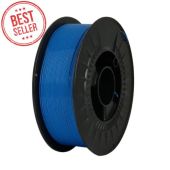How to Smooth PLA Prints for Professional Results
Smoothing PLA prints is an important step for professionals who require visually appealing and functionally accurate parts. Whether you're preparing presentation prototypes, production-grade mockups, or post-processed functional models, surface quality plays a key role in the perceived and practical value of 3D printed components. PLA is a popular material due to its ease of use and printability, but its typical layer lines often need post-processing for professional applications.
The Importance of Smoothing in PLA Printing
While PLA offers consistent extrusion and minimal warping, it often results in visible layer lines that are unsuitable for applications demanding visual refinement or surface interactions. Professionals across industries smooth their prints to achieve a polished, uniform surface, especially in use cases like:
- Design validation
- Client presentations
- Painting and coating prep
Additionally, smoother prints reduce dust accumulation and provide a more tactile-friendly surface for handling or mechanical function.
Mechanical Methods for Smoothing PLA Prints
Among the most reliable techniques, mechanical smoothing remains the go-to approach for many professionals due to its predictability and control.
Sanding is the most common first step. Starting with coarse sandpaper in the 100–200 grit range allows for initial leveling of prominent ridges. Gradually moving to finer grits—up to 1000 or higher—ensures a smooth, even surface. Using a sanding block helps maintain dimensional consistency on flat sections. Wet sanding becomes effective at finer stages, reducing heat buildup and improving surface finish. For larger parts, orbital sanders can dramatically reduce manual effort.
Polishing enhances the surface after sanding. A plastic-specific polish and microfiber cloth or rotary tool help achieve gloss and depth. However, excess heat can deform PLA, so polishing should be done with care.
Filling and priming are useful for complex geometries. Filler primers sprayed in thin layers can fill gaps and minor imperfections. Light sanding between coats ensures smooth layering and adhesion.
Key mechanical smoothing tips:
- Start coarse, finish fine when sanding
- Use wet sanding to reduce friction
- Always test polish/primers on a sample
- Protect details with light, even strokes
Chemical Smoothing Options for PLA
PLA does not respond to common solvents like acetone. Instead, ethyl acetate is used under controlled conditions to soften the outer surface and achieve a smoother, glossier finish.
<.artisan> There are two main application methods:- Brush-on application: Suitable for localized smoothing, but requires careful control to avoid uneven results.
- Vapor chamber: Exposes the print to ethyl acetate vapor for uniform smoothing across the entire surface.
Safety First: Always work in a well-ventilated space and wear protective equipment. Limit exposure time to avoid warping or weakening the part. Run tests on non-critical parts before full-scale application.
This method is best used for display models, cosmetic components, or other parts where surface quality is more important than structural strength or dimensional accuracy.
Heat-Based Surface Finishing
Thermal smoothing can be done using precision heat tools. PLA softens around 60°C, allowing selective smoothing with hot air.
The print should be slowly rotated under the heat source to avoid sagging. High-output heat guns are not recommended. This method is better for large or visual parts, not tight-tolerance components.
Pros and cons of heat smoothing:
- Fast and tool-light
- Risk of distortion is high
- Results vary with operator control
Optimizing Prints to Minimize Post-Processing
The need for heavy smoothing can often be avoided with proper printing techniques. Printing at lower layer heights, such as 0.1 mm, naturally reduces visible stepping. Clean extrusion and cooling also reduce surface defects.
Other preparation methods:
- Orient parts to minimize supports
- Use slow outer wall speeds for cleaner finish
- Keep nozzles and beds well-calibrated
- Choose high-precision filaments
Professional-grade PLA from 3D Trček is engineered to reduce visible layers and ensure dimensional consistency, making post-processing faster and easier.
Summary of Methods and When to Use Them
Each method suits a different use case. Sanding and polishing are best for strong, clean parts. Filling and priming suit display pieces. Ethyl acetate is ideal for show models, while thermal methods serve best for low-precision applications.
| Method | Best For | Key Notes |
|---|---|---|
| Sanding | Strong, clean parts | Safe, effective, time-consuming |
| Polishing | Gloss finish | Adds gloss, requires care |
| Priming | Display pieces | Covers detail, builds base for painting |
| Chemical (Ethyl Acetate) | Show models | Fast finish, structural risk |
| Heat | Visual-only parts | High-risk, operator-dependent |
Final Thoughts
Smoothing PLA prints improves quality and usability, whether you're preparing a prototype, a painted display model, or a high-precision fit. Select your method based on the technical demands and end-use of the print. When quality matters from the start, using high-performance filaments—like those from 3D Trček—can save hours in post-processing.
Understanding each smoothing approach lets professionals achieve cleaner, more functional prints while reducing time waste and rework.
; ?>) Shop PLA Filament
Shop PLA Filament 


Please complete your information below to login.
Prijava
Kreiraj novi račun